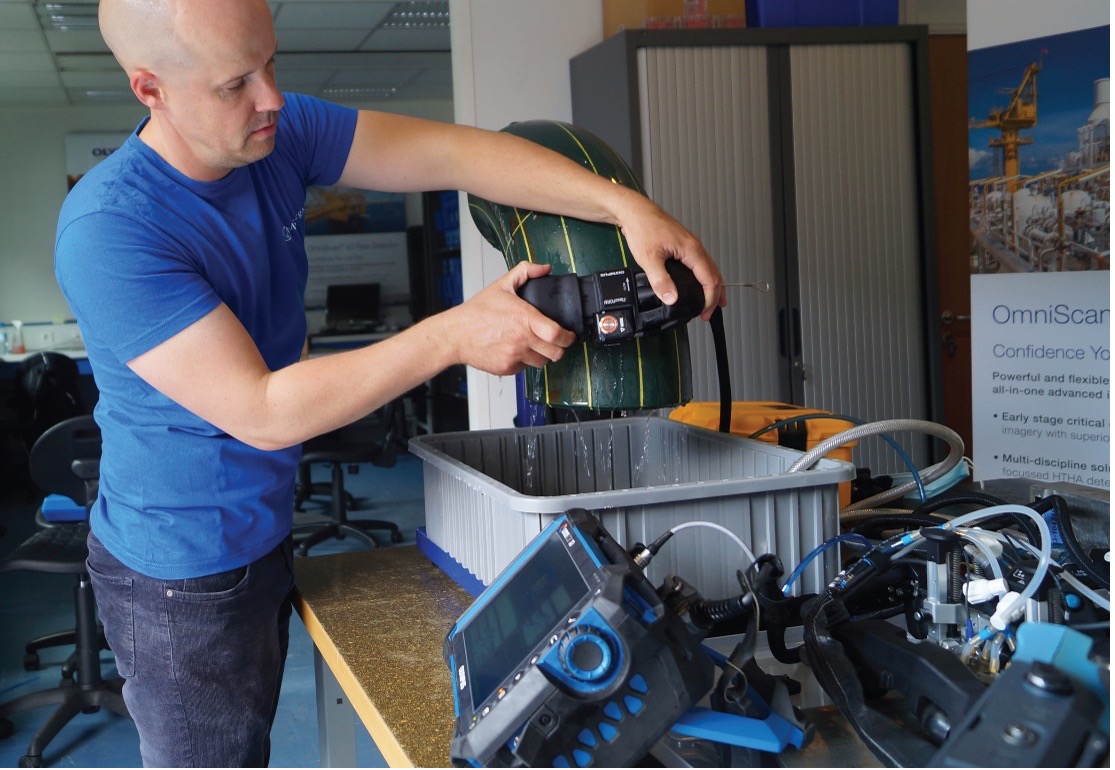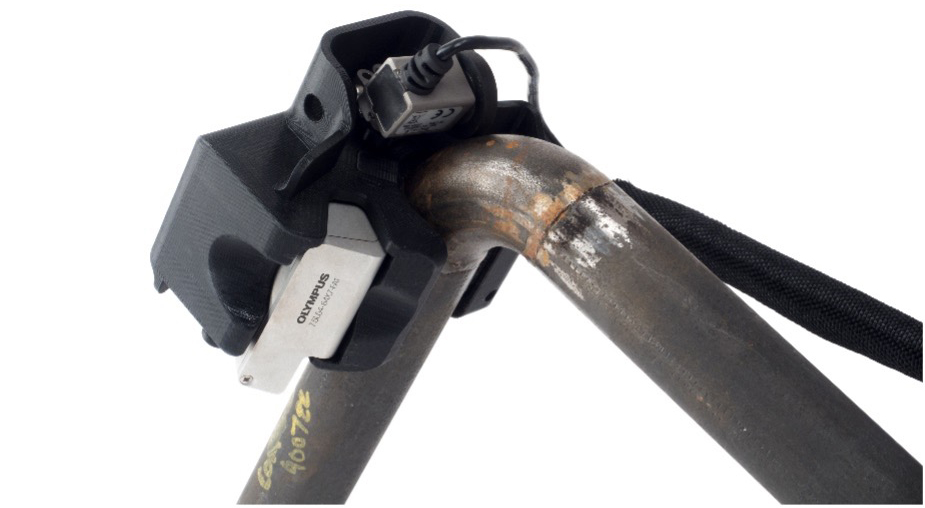Table Of Contents
- Introduction
- Role of Inspection Elbows in Pipeline Integrity
- Function of Elbow in Piping Systems
- Conclusion
- Key Takeaways
Introduction
Since 1978, the Mistras Group has been building and solidifying its reputation as a leading non-destructive testing (NDT) service and solution provider.
Specializing in acoustic emission (AE) and ultrasonic testing (UT) technologies, Mistras develops complete solutions to inspect public and industrial infrastructure, including pipe elbow scanning for extrados inspection/NDT and intrados NDT/inspection.
Based in France, Mistras serves a wide range of industries, including aeronautics, railway, renewable energy, and oil and gas.
In a recent interview with Contrôles Essais Mesures (CEM) magazine, Mistras ultrasound specialist engineer Jérôme Lethuillier spoke about the UT solution the company uses to inspect pipes, with a particular focus on pipe elbow scanning.
To illustrate its efficiency, Jerome provided an example application.
He and the Mistras team had used the solution that day at a refinery where the task was to inspect and map hundreds of meters of piping in its flare system for the purpose of Pipeline Corrosion monitoring, using the FlexoFORM™ scanner, a state-of-the-art pipe scanner.
An integral part of Mistras’ pipe inspection equipment is our FlexoFORM™ scanner, which specializes in pipe elbow scanning for extrados inspection/NDT and intrados NDT/inspection.
Jerome Lethuillier, engineer for Mistras, demonstrated the capabilities of the FlexoFORM scanner by using it on a pipe elbow sample with the OmniScan™ X3 phased array flaw detector, further enhancing the pipe inspection service they offer to customers.
What follows are selected excerpts from Jérôme’s interview in issue no.77 of Contrôles Essais Mesures (CEM) magazine (translated from French).
In it, Jerome explains what he and Mistras appreciate about the FlexoFORM scanner and how it has significantly improved their pipe elbow scanning and inspection services.
Jérôme Lethuillier, engineer for Mistras, using the FlexoFORM scanner on a pipe elbow sample with the OmniScan™ X3 phased array flaw detector (images courtesy of CEM magazine)

Role of Inspection Elbows in Pipeline Integrity
An inspection elbow, also commonly referred to as a pipe elbow, serves a critical role in various industries, particularly those involving pipelines and infrastructure.
The primary purpose of a pipe elbow is to facilitate changes in the direction of the fluid or material flowing through a pipeline while minimizing resistance and pressure drop.
This design feature is essential for maintaining the efficiency and integrity of the entire pipeline system.
Inspection elbows are crucial for examining and ensuring the structural soundness of pipelines, as they are often subject to harsh environmental conditions and potential corrosion.
Regular inspections using specialized Inspection Tools or Equipment like the FlexoFORM scanner help identify issues such as loss of thickness due to localized corrosion, making them a key element in Non-destructive Testing (NDT) and ensuring the reliability of pipelines in industries ranging from oil and gas to water distribution.
Therefore, the use of inspection elbows is not only for fluid flow management but also for maintaining the safety and longevity of the pipeline infrastructure.
Function of Elbow in Piping Systems
The function of an elbow in piping systems is multifaceted and plays a pivotal role in ensuring the smooth and efficient flow of fluids or materials through pipelines.
Elbows are primarily employed to change the direction of the pipeline, allowing it to navigate around obstacles, follow specific routes, or connect various components of the system.
This change in direction is particularly important for optimizing fluid flow, reducing pressure drop, and preventing turbulence.
Pipe elbows serve to mitigate stress and vibration within the pipeline, enhancing its structural integrity.
Beyond these fundamental functions, elbows also facilitate access for inspection and maintenance, crucial for ensuring the long-term reliability and safety of the piping system.
Essentially, the major functions of the elbow encompass redirection, flow optimization, stress management, and accessibility, all contributing to the overall efficiency and integrity of piping networks.
- Simple Operation with Automatic Indexing
“We use the FlexoFORM scanner, a state-of-the-art pipe scanner, to produce rapid and precise mapping of our customer’s very long pipelines,” said Jérôme.
“We use the FlexoFORM scanner on the lower generatrix of the piping to control, in particular, loss of thickness caused by localized Pipeline Corrosion. Once the system is installed, we scan it to cover a width of 60 mm per pass with the FlexoFORM phased array scanner. Through multiple passes, the acquisition is done line by line with an automatic indexing system. The circumference is reconstructed by sequencing. During the acquisition, the operator only needs to be sure to follow the lines drawn beforehand.” He also added, “The wheels are magnetized—the small encoder wheel is also magnetic,” alleviating some of the effort the operator needs to exert to hold the scanner on ferromagnetic surfaces for precise pipe scanning.
- 100% Elbow Coverage and Full Circumference Mapping
“We also use the FlexoFORM on elbow sections. This equipment offers us a solution that we did not have until now. We used very small traditional probes to perform spot Thickness Measurements. This grid sampling did not enable us to perform 100% verification. Also, we had no rendering in terms of imagery. With the FlexoFORM scanner, we can inspect the entire surface and produce a map.”
High-resolution data (1 × 1 mm) on a Wide Range of Pipe Diameters
“In addition, this equipment makes it possible to detect damage that is small in size, something we could not achieve with sampling measurements. The FlexoFORM scanner meets, for us, a need for which we had no technical solutions. We also use the mini FlexoFORM scanner to inspect small-diameter pipes. With its more suitable footprint, we start at 1.3 inches. With traditional FlexoFORM equipment, we work on diameters of at least 4 inches and can control very large diameters.”
“The FlexoFORM scanner meets, for us, a need for which we had no technical solutions.”— Jérôme Lethuillier, Mistras UT Specialist Engineer

- Flexible, Adaptable Phased Array Probe and Curved Water Wedge System
“The phased array probe is flexible. It can accommodate diameters greater than 1.3 inches, down to flat surfaces. We attach water wedges to it according to the radius of curvature. A system of different water wedges covers a wide range of diameters. Being able to remove the probe, without tools, is very valuable in the field because on Pipelines, diameter changes are frequent. On straight sections, being able to record data in the longitudinal direction changes everything. Previously, rigid probes were moved around the circumference of the pipe before incrementing and making another turn. Being able to control whole sections over great lengths enables us to save a lot of time.
“On straight sections, being able to record data in the longitudinal direction changes everything.”
- More Efficient Acquisition and Intuitive C-Scan Imaging
“In terms of image rendering, the thickness maps generated are the same as with our previous systems. On the other hand, we can now map large areas, thus saving a lot of acquisition time and time spent on site. In terms of mapping, again, it’s now possible for us to map the surface of elbow sections, which is a real plus. Despite the flexible probe without shock absorption at the back, the signal quality is really good, as are the mapping images. The FlexoFORM scanner also enables us to monitor identified damage over time, to control any degradation to complex geometries (intrados and extrados),” explained Jérôme.
“It’s now possible for us to map the surface of elbow sections, which is a real plus.”
- A Specialty Pipe Elbow Scanning Solution That Optimizes Mistras’ Offering
“Searching for new solutions is part of our mission because it enables us to extend our range of services and offer our customers services with ever greater productivity. This is also why we have one of the richest arrays of Advanced NDT Techniques or solutions on the market because we want to provide the most complete response possible to their specific problems.”
Conclusion
Elbows in piping systems are essential components that serve a range of critical functions.
They enable the redirection of fluid flow, optimize pressure, minimize turbulence, manage stress, and provide access for inspection and maintenance.
The efficient operation of pipelines in various industries relies on well-designed and strategically placed elbows.
Their multifaceted role ensures that Pipelines maintain structural integrity, operate smoothly, and remain reliable over the long term, making elbows indispensable in the world of fluid transport and infrastructure management.
Key Takeaways
- Elbows in piping systems play a vital role in redirecting fluid flow, optimizing pressure, managing stress, and providing access for inspection and maintenance, making them indispensable for efficient and reliable pipeline operation.
- The FlexoFORM product is a crucial element in the inspection of elbows, offering advanced capabilities in Non-destructive Testing (NDT) to ensure the structural soundness and longevity of pipelines.
References
1. Mistras Group
2. Olympus









